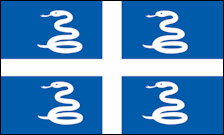Martinique - People
 The territory has 380,000 inhabitants spread over 34 municipalities. Martinique is truly a land of tradition and culture, with a rich history of crafts and literature by renowned authors and famous poets, music and dance, lifestyle and gastronomy. Its multi-ethnic population stems from the cultural mixing of the island’s successive inhabitants: Amerindians, Europeans, Africans, Indians, Levantines and Asians. Approximately one quarter of the population resides in the administrative capital, Fort de France. Numerous religious denominations are present in Martinique. The official language is French, although everyone speaks Creole, a language that is a blend of Old French, English, and African languages, as well as surviving Amerindian terms.
The territory has 380,000 inhabitants spread over 34 municipalities. Martinique is truly a land of tradition and culture, with a rich history of crafts and literature by renowned authors and famous poets, music and dance, lifestyle and gastronomy. Its multi-ethnic population stems from the cultural mixing of the island’s successive inhabitants: Amerindians, Europeans, Africans, Indians, Levantines and Asians. Approximately one quarter of the population resides in the administrative capital, Fort de France. Numerous religious denominations are present in Martinique. The official language is French, although everyone speaks Creole, a language that is a blend of Old French, English, and African languages, as well as surviving Amerindian terms.
The main urban area is Pointe-à-Pitre with 315,000 inhabitants. The island has an international airport on the plain of the municipality of Lamentin. The city of Schoelcher is the third largest city. Diseases such as dengue fever or sickle cell disease are common in the West Indian population. Martinique also remains a department very affected by AIDS. No special vaccination is required on the island. Martinique has 1,480 physicians in 2016, about half of whom are general practitioners and half of specialists. The Pointe-à-Pitre University Hospital (CHU) has 881 beds and receives more than 73,000 passages in its emergency department. The Martinican population remains very young compared to the national average with almost one third under the age of 20 years. Nevertheless, the share of elderly people is increasing and needs to be adjusted.
Education is compulsory through to the primary and secondary levels. There are 269 primary schools and 77 secondary schools. The enrolment in the 2005/2006 term was 99451 pupils. The University Antilles Guyana in Martinique focuses on economics, politics, law and the humanities. There is also a Master Formation University Institute (IUFM) for teachers’ training; as well as an informatics school and an international business and management school run by the Chamber of Commerce and Industry of Martinique. Other organisations provide job specific and other vocation training. Adult Literacy: 92%; Male: 90%; Female: 90%.
If recent trends continue, the population of Martinique would continue to decline to 339,000 in 2030, a decrease of 12% from 2013. This demographic decrease would be mainly due to the natural balance which would become negative, as births no longer compensate for deaths. Indeed, fertility decline and the many departures of young people lower the fertility rate mechanically and the aging of the population induces an increasing number of deaths.

|
NEWSLETTER
|
| Join the GlobalSecurity.org mailing list |
|
|
|

